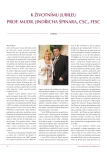Primary hyperaldosteronism: the most common form of secondary hypertension
Authors:
J. Widimský jr.
Authors‘ workplace:
Centrum pro hypertenzi, III. interní klinika VFN
a 1. LF UK v Praze
Published in:
Kardiol Rev Int Med 2010, 12(2): 77-79
Overview
Primary hyperaldosteronism as the most common cause of the endocrine as well as the secondary hypertension results from autonomous over-production of mineralocorticoids (aldosterone) by the adrenal gland, leading to high levels of aldosterone, suppressed renin and arterial hypertension. Most frequently this is bilateral over-production of aldosterone (idiopathic type) consequent to bilateral adrenal hyperplasia and unilateral aldosterone-producing adenoma. Primary hyperaldosteronism should be considered and the basic screening investigations should be performed in the following categories of patients: moderate and severe hypertension, treatment-resistant hypertension, hypertension and hypokalaemia, hypertension and enlargement of one or both adrenal glands. However, diagnostics and therapy of primary hyperaldosteronism are associated with some difficulties and thus every patient with suspected primary hyperaldosteronism should be examined at a specialized hypertension centre.
Keywords:
primary hyperaldosteronism – hypertension – prevalence – diagnostics – treatment
Sources
1. Widimský J jr. Sekundární hypertenze. Praha: Triton 2003: 1–151.2. Litynski M. Nadcisnienie tetnicze wyvolane guzami korowo-nad-nerczowymi. Pol Tyg Lek 1953; 8: 204–208.
3. Conn JW. I. Painting background. II. Primary aldosteronism, a new clinical syndrome. J Lab Clin Med 1955; 45: 3–17.
4. Lifton RP, Dluhy RG, Powers Met al. A chimaeric 11 beta-hydroxylase/aldosterone synthase gene causes glucorticoid-remediable aldosteronism and human hypertension. Nature 1992; 355: 262–265.
5. Seeman T, Widimský J, Hampf M et al. Abolished nocturnal blood pressure fall in a boy with glucocorticoid- remediable aldosteronism. J Human Hypertension 1999; 13: 1–6.
6. Widimský J jr. Primární hyperaldosteronismus: epidemie anebo jen častá příčina sekundární hypertenze? Cor et Vasa 2008; 50: 366–367.
7. Funder JW, Carey RM, Fardella C et al. Endocrine Society. Case detection, diagnosis and treatment of patients with primary aldosteronism: An Endocrine Society Clinical Practice Guideline. J Clin Endocrinol Metab 2008; 93: 3266–3281.
8. Kaplan NM (ed.). Clinical Hypertension. 8th ed. Philadelphia: Lippincott Williams & Wilkins 2002: 1–550.
9. Fritsch NM, Schiffrin EL. Aldosterone: a risk factor for vascular disease. Curr Hypertens rep 2003; 5: 59–65.10. Štrauch B, Petrák O, Wichterle D et al. Increased Arterial Wall Stiffness in Primary Aldosteronism in Comparison with Essential Hypertension. Am J Hypertens 2006; 19: 909–914.
11. Holaj R, Zelinka T, Wichterle D et al. Increased intima-media thickness of the common carotid artery in primary aldosteronism in comparison with essential hypertension. J Hypertens 2007; 25: 1451–1457.
12. Gordon RD, Stowasser M, Rutherford JC. Primary aldosteronism: are we diagnosing and operating too few patients? World J Surg 2001; 25: 941–947.
13. Mulatero P, Dluhy RG, Giacchetti G et al. Diagnosis of primary aldosteronism: from screening to subtype differentiation. Trends Endocrinol Metab 2005; 16: 114–119.
Labels
Paediatric cardiology Internal medicine Cardiac surgery CardiologyArticle was published in
Cardiology Review

2010 Issue 2
Most read in this issue
- Catheter closure of PFO and paradoxical systemic embolisation
- Transcranial colour-coded duplex sonography to evaluate intracranial arteries in patients with cerebrovascular stenooclusive disease – review
- Primary hyperaldosteronism: the most common form of secondary hypertension
- Hypertension treatment in patients with metabolic syndrome
